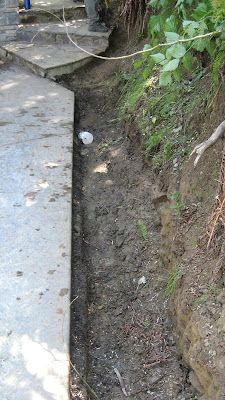 |
| Dry stone fence, limestone, Kentucky. Image by Mark Jurus. |
Why do these dry stone structures last so long? Luck? Lack of exposure to extreme elements? Freeze thaw not present in certain elements????
There are as many theories as there are people who have put one stone upon another. You can go to school and be instructed to build a wall to certain standards of quality. You can also build walls with a naivety to any of those rules. Both walls will have have certain truths that endear them to their own longevity. A friend of mine has said many times in my presence….”a poorly built wall often lives way longer than it should…”. They do… wether they are pleasing to look at, or chaotic and terrifying in their relationship to the site.
For me it always starts the same for a new wall. I have to slow down and assess the landscape. This often takes me a while as I try and picture a new wall working in the landscape for the client as they intend it to. Eventually we come to ‘yes’ for the landscape/client/and myself.
After the site is assessed, the wall is defined to height-length-materials-thickness-drainage… you begin work. You excavate for your foundation. Foundations are to me one of the more beautiful details that hidden within the wall. Many times the only time a foundation is seen by the client is as a line item outlining our scope of work, or by the subtle edge that protrudes 3-4″ proud beneath the face of the dry stone retaining wall or fence.
The foundation is, to me, one of the most important details in walls. There is a reason we use that phrase ‘solid foundation’ in a hundred different analogies in life. We don’t want what is above grade to shift, or become insecure because of what is at our feet is not solid. Foundations vary incredibly according to region, site conditions, materials, engineering specifications, surcharge of slopes, and also personal experience of the contractor.
The Dry Stone Conservancy in Kentucky, when I went through their ‘Boot Camp’ program to obtain my basic certification through them, said that by adding a foundation to our walls of 4-6″ thick stones, that protrude 3-4″ on the face of dry stone retaining walls/and the same for dry stone fences, will add an estimated 25-50 years for a walls longevity. The foundation! I think this is where I fell in love with working with stone and thinking about the quality of materials and the relationship of the craftsman to a deep timeline long after they mason is gone.
I’ll use this site as an example because it was relatively easy…. It is totally clear why the client wanted a 48″ tall dry stone retaining wall along their driveway. We chose a blocky Montana slate to work with…..
After digging down, and cutting back into the hillside we realized we were sitting on our local sandstone bedrock. We also had a drainpipe we could remove excess water from below and behind the wall.
This was an easy foundation because we could build right up off the sandstone. We did three things. One was cutting the grade of the sandstone level, and running the back of the wall a few degrees below the front. And the second was to install a 4″ drain pipe behind the wall, with a clean out under the lentil detail. We also removed the cedar tree on the edge of the cut to prevent it from growing roots into the wall and pushing it over, and or getting toppled by high winds and wet soils in the winter/spring.
So here you can see a detail of the finished wall with the tree removed(and all the blackberries), and the clean out access detail for water to collect in.
Other foundations…….
Above you can see Forest building a dry stone retaining wall out of Idaho Quartzite that will finish out at 48″ tall. At his feet you can see the detail of the foundation protruding 4-5″. In our part of the world the inspectors measure walls height from the bottom of the first stone.
Here is a finish detail of the wall before plants went in…. The pattern language of the foundation stones is picked up with the large cap stones.
We can return to this fence that has a few unique elements incorporated to it.
This site needed to incorporate a passageway for a seasonal stream that appeared during heavy rains, and lintels above the root structure of the ‘witness tree’ in Shaker Village. The foundation is entirely below water water line. Here I rebuilt the wall the had failed because of the tree and a broken lintel stone. After I stripped it out, I added foundation stones which will greatly strengthen the wall. The tree however will pull it apart again over time as the roots were monsters that should have been removed. By the way… trees love stone walls because the provide shade, and harbor moisture.
In some cases their engineer, or landscape architect, specifies something a little more extreme. In this case the client wanted a dry stone retaining wall look along their man made lake in Ontario. In this project my friend had to build on a concrete foundation and concrete wall behind the stone. The wall had large cap stones 3′ x 3′ x 6″ thick mortared down to the stone. It was designed to show the top 12″ in summer when the lake was full, much less in the winter as it receded, but also because of the freeze thaw and heaving.
This project is being built in Bellingham Washington. Our wall was engineered in context to the ‘critical slope’ behind it, the sandstone bedrock, our desired finish height of 6-7′, and drainage. For this project we had to remove all topsoil, and ‘toe’ our wall into bedrock 6″. That was about 11-13″ below grade! In the first image you can see our foundation stones for our granite foundation stones. Crazy right? You can see in the second image those stones protruding 3-4″. Also note our drain pipes behind the walls to remove excess water content. All the gravel came out as we installed our foundation stones.
I have seen many walls built on gravel of varying depths, on asphalt, over fallen logs/boulders, and stone. Every structure built should be honored with the foundation being properly built. Why waste the time to build a structure without a solid foundation?
As you can see every walls foundation is critical in context to the site, as well as the finished structure.




